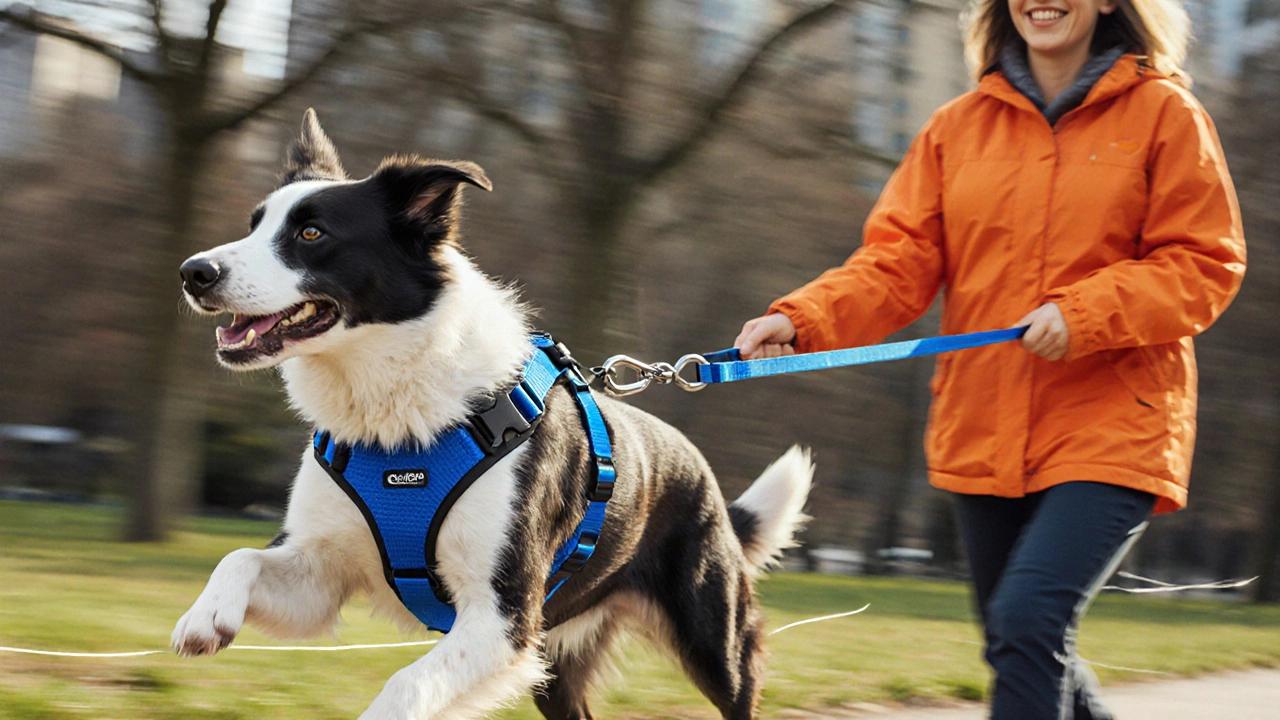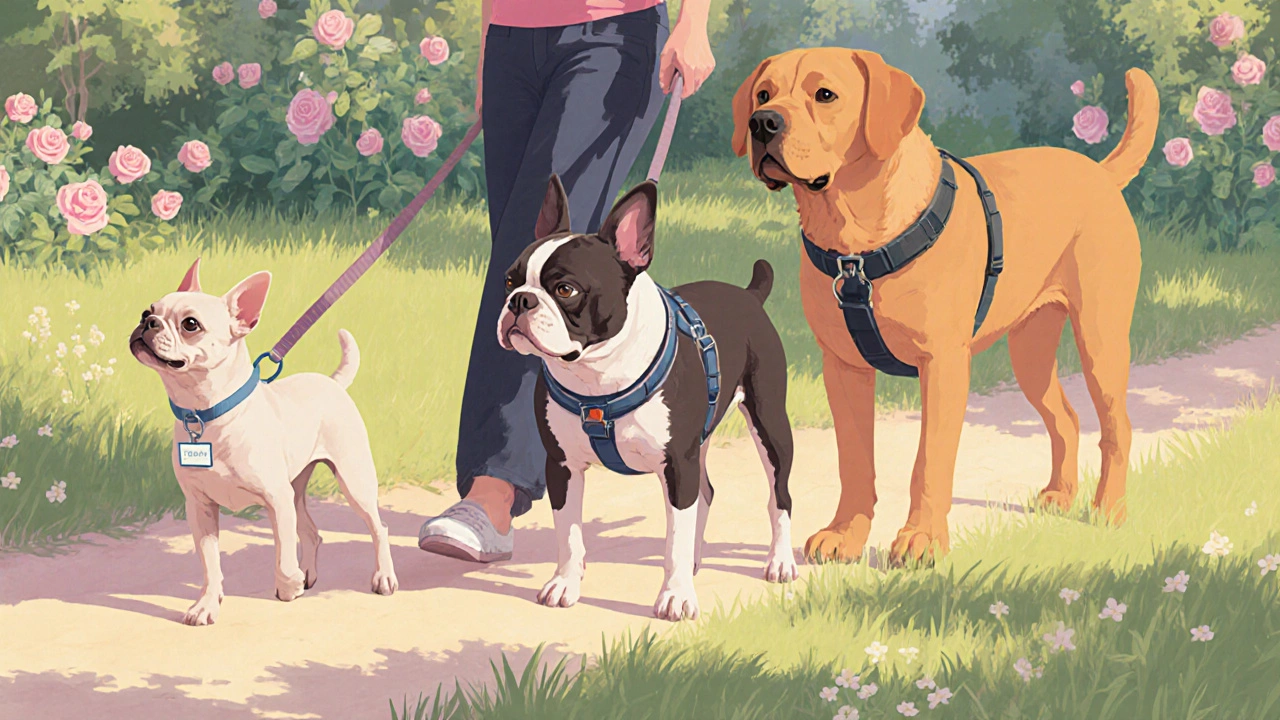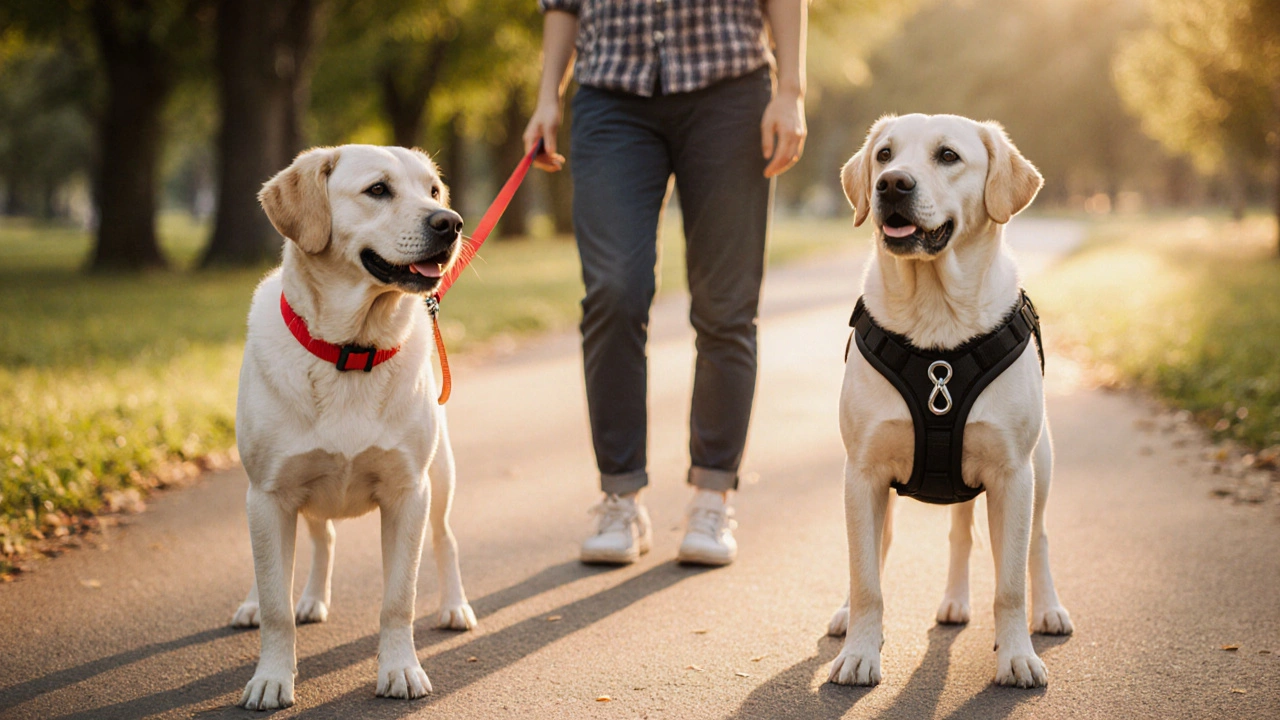When it comes to everyday walks, the choice between a Dog collar a band that wraps around a dog’s neck and attaches to a leash and a Dog harness a torso‑fitted device that distributes pulling force across the chest and shoulders can feel like a toss‑up. In practice the decision boils down to three jobs you’d like the gear to do: keep your pet safe, give you control, and stay comfortable for both of you.
Key Takeaways
- A collar works well for small, well‑trained dogs that don’t pull.
- A harness is safer for strong pullers, brachycephalic breeds, and dogs with neck problems.
- Choose a style that matches the walk’s purpose - training, jogging, or casual strolls.
- Fit matters more than brand; a poorly fitted collar or harness can cause injuries.
- Regularly inspect and adjust the gear as your dog grows or gains/loses weight.
How a Collar Works (and When It’s a Good Fit)
A dog collar vs harness debate often starts with the classic flat collar. This simple band sits around the neck, usually with a metal or plastic buckle. It’s quick to put on, cheap, and works great with a standard leash. For puppies under 10lb that respond to voice cues, a flat collar paired with a short leash can teach basic leash manners without overwhelming the animal.
Different collar types serve niche needs:
- Flat collar a single‑layer nylon or leather band - best for identification tags.
- Martingale collar a limited‑slip design that tightens slightly when the dog pulls, preventing escape without choking - ideal for breeds with narrow heads (e.g., Greyhounds).
- Training collar a tool that delivers mild vibration, sound, or static correction for advanced obedience work - recommended only for experienced handlers.
In terms of safety, a collar puts all pulling force on the neck. If your dog lunges at a squirrel, the sudden jerk can strain the trachea, spinal vertebrae, or delicate blood vessels. Dogs with respiratory issues (pugs, bulldogs) or a history of neck injuries should avoid high‑tension collars altogether.
How a Harness Works (and Why It’s Often Safer)
A Dog harness a piece of equipment that loops around the chest and sometimes the back, attaching to a leash via a D‑ring spreads the pulling force over a larger area. This reduces pressure on the neck and spine, making it a safer option for most adult dogs.
Common harness styles include:
- No‑pull harness features a front‑clip D‑ring that redirects the dog’s forward momentum when they pull - great for training puppies to walk politely.
- Step‑in harness allows the dog to step through a wide opening, minimizing stress on the neck and shoulders during wear - useful for senior dogs with limited mobility.
- Chest harness wraps around the ribcage and attaches at the chest, offering excellent control without choking - the go‑to for active breeds like Labradors and Border Collies.
Because the leash attaches to the chest instead of the neck, a harness prevents the ‘wind‑up’ effect that can damage a dog’s trachea. For dogs that love to pull, a no‑pull harness not only protects them but also gives the owner a mechanical advantage: when the dog lunges, the front‑clip rotates the body toward the owner, encouraging a turn‑in‑place rather than a straight‑ahead dash.
Fit Matters More Than Brand
Whether you pick a collar or a harness, the fit decides the outcome. A loose collar can slip off, while a tight one can chafe. The same rule applies to harnesses:
- Measure the dog’s girth (around the ribcage) and neck circumference.
- Adjust all straps so you can slip two fingers between the harness and the body.
- Check for rubbing points after the first walk; reposition straps if you see red marks.
Remember that puppies grow quickly - re‑measure every month until they’re fully grown. Adult dogs can lose or gain weight, so a quarterly check keeps the gear comfortable.

Pros and Cons: Quick Comparison
| Factor | Dog Collar | Dog Harness |
|---|---|---|
| Safety for pullers | Higher risk of neck injury | Distributes pressure, lower risk |
| Ease of use | Quick to slip on/off | May require adjustments, especially on the first wear |
| Control on training walks | Limited - relies on leash tension | Front‑clip designs give directional control |
| Best for small breeds | Ideal for lightweight dogs with calm gait | Works for all sizes, but small dogs may need a lightweight harness |
| Cost range | $5‑$30 | $15‑$60 |
When to Choose One Over the Other
Here’s a quick decision tree you can run through before you buy:
- If your dog doesn’t pull and has no neck or breathing issues → a flat collar with ID tags is sufficient.
- If your dog tends to pull and you need immediate control → start with a no‑pull harness.
- If your dog is a brachycephalic breed (e.g., French Bulldog) → avoid high‑tension collars; a step‑in harness is kinder.
- If you train for agility or jogging and need a secure attachment point → a chest harness with a sturdy D‑ring works best.
- If you need a lightweight solution for quick vet visits and still want a tag holder → a martingale collar offers limited slip without choking.
Maintenance Tips for Longevity
Both collars and harnesses endure wear and tear. Keeping them in good shape protects your dog and saves money:
- Wash nylon or fabric harnesses in cold water and air‑dry; leather collars need a leather conditioner.
- Inspect buckles, D‑rings, and stitching after each walk; replace any frayed parts immediately.
- Rotate between two collars or harnesses if you walk multiple dogs; this reduces stress on any single piece.

Real‑World Stories
Emma, a Dublin‑based rescue volunteer, shared how switching from a collar to a chest harness saved her rescued Labrador, Max. Max loved to pull on the leash, and after a few months the vet diagnosed a minor tracheal irritation. The new harness eliminated the irritation, and Max’s walks became calmer.
On the flip side, Tom, who owns a tiny Chihuahua named Bella, found that a lightweight flat collar was perfect. Bella never pulls, and the collar lets her wear a cute bow tie without bulk.
FAQs
Frequently Asked Questions
Can I use a collar for a dog that has a broken neck?
No. A broken or weak neck requires a harness that distributes pressure across the chest. Even a loose collar can shift and worsen the injury.
What size harness should a 30‑lb adult Labrador wear?
Measure the girth just behind the front legs. For most 30‑lb Labs the chest measurement falls between 22-26inches, so a medium‑large chest harness will fit comfortably.
Do harnesses interfere with a dog’s natural gait?
A well‑fitted harness should not alter gait. If you notice your dog walking on tip‑toes or favoring a side, the straps are likely too tight or positioned incorrectly.
Should I still use a collar for ID tags if I use a harness?
Absolutely. Many owners attach a lightweight ID tag to a small flat collar worn under the harness, ensuring the tag stays visible while the harness provides control.
Is a martingale collar a good middle ground?
For dogs that slip out of regular collars but don’t need a full‑body harness, a martingale offers limited slip without choking. It’s a solid compromise for many medium‑size breeds.
Bottom line: there’s no one‑size‑fits‑all answer. Match the gear to your dog’s size, pulling style, and health history, and you’ll enjoy safer, happier walks together.

